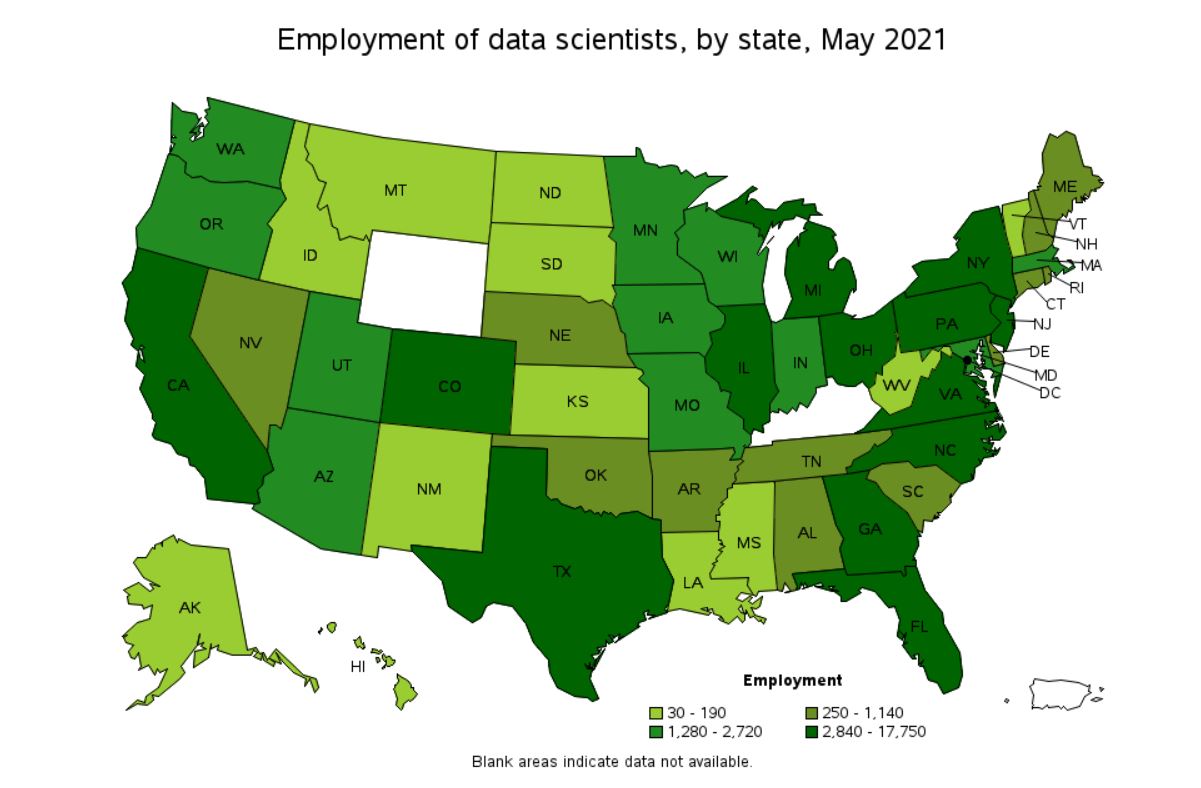Data Science is among the fastest-growing fields in today’s technological world. Nearly all industries are data-intensive and use massive amounts of data to make better business decisions.
Computer Systems Design, Management, Consulting, and Credit Intermediation companies employ the highest number of data scientists. The Bureau of Labor Statistics reports Computer Systems Design and Related Services employs 16,620 data scientists with an average salary of $ 116,300.
The below infographic shows the states that employ the most data scientists, with California, New York, and Texas leading the pack.

Source: Bureau of Labor Statistics
The above data suggest that companies need a regular supply of data scientists to perform their daily activities. However, firms find it challenging to attract and retain highly skilled data scientists due to many reasons like inadequate recruitment process, poor employer brand, etc.
We’ve created a comprehensive step-by-step guide to hiring exceptional data scientists. This guide includes the best practices you can use for testing new data science candidates so you have a streamlined recruitment process.
Your Guide on Hiring a Data Scientist
Industry experts recognize the value of data in today’s business world. Some compare it to the significance of oil in the 20th century, while others believe it plays a much more significant role. Data scientists are expected to be at the forefront of this technological revolution and play a vital role in the coming years.
Bob Hayes, Ph.D., former Chief Research Officer at Appuri, says this about data science and its methods:
“I think of data science as more like a practice than a job. Think of the scientific method, where you have to have a problem statement, generate a hypothesis, collect data, analyze data and then communicate the results and take action…. If you just use the scientific method as a way to approach data-intensive projects, I think you’re more apt to be successful with your outcome.”
We recommend you follow the step-by-step procedure provided below to hire and retain brilliant data scientists for a considerable time.
Step 1: Write Compelling Job Descriptions
A well-written job description is critical for attracting the most qualified and talented people toward a job opening. The importance of job descriptions is even greater in technical roles like data scientist, machine learning engineer, data architect, or healthcare analyst. A data scientist’s job description should clearly define the roles and responsibilities and briefly mention information about the company.
Here are the best practices the leading tech companies followed in their data science job descriptions:
- Keep job descriptions brief and easy to understand. A data scientist’s job description starts with an impactful explanation of the position that briefly discusses its importance. Describe the position’s relationship to your organization and its unique qualities. The summary is your chance to give potential candidates some background knowledge and insight into the role.
- Also, most candidates apply to multiple positions and skim the job description. Hence, it is necessary to keep the job description concise while capturing the candidate’s attention. Hiring managers should also avoid using technical jargon as it may offend some people.
- Speak directly to the applicants using second-person pronouns like ‘you’ and ‘your’ to establish credibility. In addition to the compensation and benefits, briefly talk about the growth aspects of the role and how it will help the candidates achieve their personal goals.
Step 2: Post On Niche Job Boards Often
Linkedin, Indeed, and Glassdoor are the leading job boards and platforms where candidates look for jobs. There is a significant disadvantage to hiring from these platforms, despite the fact that they are unquestionably effective and will draw hundreds of brilliant people. Ironically, their most important advantage is high volume, which can also be a huge downside.
A job posting on the above-mentioned platforms is indeed more likely to be seen by more candidates, but it could come at the cost of quality. Companies who hire from these platforms receive hundreds of applications but find it challenging to select suitable candidates from a pile of unqualified candidates. That is why tech firms looking to recruit excellent data scientists should post on niche job boards like Benchpoint.
The volume on these platforms might be lower than the mainstream ones, but here you’ll find applicants better suited to a technical role like data scientists.
Step 3: Invest in the Right Recruitment Software
Automation is becoming integral to modern business practices, including HR and recruitment. Recruitment software is the epitome of HR automation as it automates the menial tasks associated with recruitment and hiring. After posting the job opening on a job board, you’ll get a large number of applications that must be correctly assessed to find the right candidate.
Such tasks can be easily automated with recruitment software like Application Tracking Systems (ATS), which have become increasingly popular in multinational companies. Get App surveyed hiring managers who use ATS about their satisfaction levels. 86% said that ATS improved their hiring speed and streamlined their recruitment. The below figure shows their responses when asked about the effectiveness of ATS in the hiring process.

Source: Get App
Step 4: Focus on Candidate Skill Testing
After following the aforementioned steps, the next part is to assess the technical skills of a candidate. As data science is highly specialized, an applicant must have all the necessary skills to be a successful data scientist. Here are the most in-demand skills for a data science professional.
- Programming skills
- Languages like Python, Java, C/C++
- Applied Mathematics and Statistics
- Database Management tools
- SQL and NoSQL
- Data Mining Tools
- Machine Learning
- Data visualization tools like Tableau
Most companies have sophisticated testing procedures to assess candidates’ skills in the aforementioned areas. You can follow the same practice or consult an expert to conduct the testing phase on your behalf.
Step 5: Use Structured Interviews
Most data science candidates decide to quit a potential employer during the interview phase. Undoubtedly, businesses must update their hiring practices and use structured interviews whenever possible.
Unstructured interviews only accurately predict 14% of a candidate’s actual success on the job, according to a Wired study, only ahead of background checks at 7%.
The utilization of a set of common questions is an essential component of structured interviews. In contrast to unstructured interviews, where the interviewer does not prepare a list of prepared questions, these questions are frequently written before the interview starts.
You may improve the candidate experience, maintain objectivity, and use a hiring strategy that is legally defendable with the aid of a systematic interviewing process. Closed-ended interview questions allow you to compare and contrast the responses of candidates seeking positions in data science.
Step 6: Find Ways to Onboard Effectively
The final step after selecting suitable candidates for the role of a data scientist is onboarding. Onboarding, also known as organizational socialization, is the process through which new hires learn the information, abilities, and behaviors required to function successfully as insiders and members of the organization. It contains exercises that enable brand-new hires to finish the new hire orientation process and learn about the company’s structure, culture, vision, mission, and values.
Many tech firms overlook or neglect the importance of onboarding new data scientist candidates. A Gallup study reported that only 12% of applicants agree their organization does a good job of onboarding.
Attracting and retaining data science candidates is easier when employers know what candidates seek. By utilizing the above-mentioned tactics and best practices, businesses may attract and keep the world’s greatest data science talent.
Contact BenchPoint, a healthtech recruitment company, to learn more about how to find the most remarkable data scientist specialists with more efficiency. With time, we’ll work with you to create employee-focused and result-driven workplaces, and we’ll be pleased to assist you with even the most straightforward problems.
